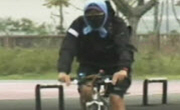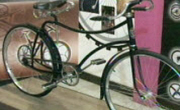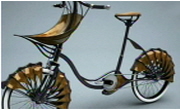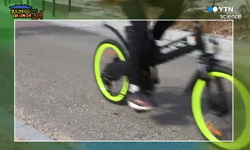우리나라는 1995년 「자전거이용 활성화에 관한 법률」이 제정되어 자전거 관련 사업이 전국적으로 진행되어 왔으며, 최근에는 자동차를 대체할 수 있는 친환경 녹색교통 수단에 대한 관심...
http://chineseinput.net/에서 pinyin(병음)방식으로 중국어를 변환할 수 있습니다.
변환된 중국어를 복사하여 사용하시면 됩니다.
- 中文 을 입력하시려면 zhongwen을 입력하시고 space를누르시면됩니다.
- 北京 을 입력하시려면 beijing을 입력하시고 space를 누르시면 됩니다.
https://www.riss.kr/link?id=T12501065
- 저자
-
발행사항
서울 : 서울시립대학교, 2011
-
학위논문사항
학위논문(석사)---- -- 서울시립대학교 도시과학대학원 , 도시계획학과 , 2011. 8
-
발행연도
2011
-
작성언어
한국어
- 주제어
-
KDC
539.7U 판사항(4)
-
발행국(도시)
서울
-
형태사항
vii, 122p : 삽도 ; 26cm.
-
일반주기명
A study on the utilization of bicycle for commuting to school
지도교수:양승우
참고문헌 : p.97-98 - 소장기관
-
0
상세조회 -
0
다운로드
부가정보
국문 초록 (Abstract)
우리나라는 1995년 「자전거이용 활성화에 관한 법률」이 제정되어 자전거 관련 사업이 전국적으로 진행되어 왔으며, 최근에는 자동차를 대체할 수 있는 친환경 녹색교통 수단에 대한 관심이 더욱 증대되면서 자전거를 생활교통수단으로 바꾸기 위한 여러 가지 정책을 추진하고 있다.
이 중 도로다이어트를 통한 자전거전용도로의 설치는 초기에는 도심 내 자전거전용도로 확대라는 취지로 자전거 이용자들의 많은 환영을 받았지만, 설치 이후에는 주변도로 교통 혼잡과 자전거 안전사고 발생 등의 문제가 계속 제기되면서 이러한 자전거전용도로 설치가 실제 생활교통 자전거이용 활성화에 효과가 있는지 의문시 되고 있다.
본 연구에서는 생활교통 자전거, 특히 통학을 목적으로 하는 자전거를 대상으로 자전거 이용 특성을 분석하여 기존 자전거 정책의 문제점을 제시하고, 이를 바탕으로 생활교통 자전거이용 활성화 방안을 제시하고자 한다.
먼저 본 연구 수행을 위해, 서울시 영등포구 관악고등학교를 대상지로 선정하여 설문조사 및 현지조사를 하였으며, 그 결과 통학수단 선택은 집에서 학교까지 가장 빠르고 편리한 수단이 무엇인지에 따라 결정된다는 것을 알 수 있었다. 또한 자전거 이용자는 집에서 학교까지 직선거리로 800m~1.6km 범위 내에 과반수이상 분포하고 있었으며, 이들의 통학 시간은 최소 5분에서 최대 30분 평균적으로 15분 정도 걸리는 것으로 나타났다.
일반적으로 자전거 통학 노선 선택 시 영향을 미치는 주요 요소는 보도와 분리된 자전거전용도로가 설치되어 있는지, 자동차ㆍ보행자와 충돌위험이 적은지, 통행시간은 최소화되는지 이었으며, 자전거 통학을 활성화하기 위해서는 보도와 분리된 자전거전용도로 설치가 가장 우선적으로 개선되어야 한다고 생각하고 있는 것으로 분석되었다.
그러나 실제 이용하는 자전거 통학노선을 분석한 결과 자전거전용도로 유ㆍ무와 같은 물리적 특성이 가장 우선시되기보다는 개개인의 집에서 학교까지 가는 최단경로가 기본이 되고 방황전환이 적고 보도 폭이 넓거나 장애물이 적은 노선의 자전거 이용 빈도가 상대적으로 높게 나타났다.
이러한 결과를 종합해보면, 자전거를 통학 수단으로 활성화하기 위에서는 버스나 지하철 같은 다른 대중교통 수단이 없으며, 집에서 학교까지 자전거로 통학하기에 적당한 거리에 위치한 주거 구역을 선정하여 집에서 학교까지 최단경로의 통학노선을 우선적으로 지정하고 주행여건이 양호할 수 있도록 정비하는 것이 가장 효율적이 방법이라고 볼 수 있다.
자전거 통학 노선을 정비하기 위한 가장 좋은 방법은 보도와 분리된 자전거전용도로망의 확충이지만, 무조건적인 자전거전용도로 설치는 실제 자전거이용 활성화에 도움을 주지 못한다. 조사 결과에서도 알 수 있듯이 도심 내 도로다이어트를 통한 자전거전용도로의 설치는 현실적인 물리적 공간의 한계로 인해 불완전할 수밖에 없으며 자전거 이용자들에게 외면받기 십상이다.
그러므로 자전거전용도로의 확충이 어려운 지역은 불완전한 자전거전용도로 대신 자전거ㆍ보행자 겸용도로를 정비하여 보완할 수밖에 없다. 가장 중요한 요소는 집에서 학교까지 연결하는 통학 노선이 단순하고 유기적으로 연결되어야 하며 통행에 불편을 주는 장애물이 없어야 한다는 것이다.
즉, 집에서 학교까지 통학 노선의 유기적인 연결성 확보를 위해 기존 자전거ㆍ보행자 겸용도로의 지속적인 유지ㆍ관리가 필요하며, 노선상의 장애물 단속 및 학교의 정책적 지원, 제도개선 등을 통해서 자전거를 편리하게 이용할 수 있는 환경을 만들어나가야 한다.
이를 바탕으로 신규로 중ㆍ장거리 자전거전용도로를 설치하는 것을 가능한 지양하는 대신 근거리에서 자전거를 적극적으로 활용할 수 있는 환경을 만드는 쪽으로 정책이 변화될 수 있도록 지원하여 생활교통 자전거이용이 활성화되는데 도움이 될 수 있기를 기대해본다.
다국어 초록 (Multilingual Abstract)
In our country "Bike Use Invigoration Act" was enacted in 1995, promoting bike-related projects nationwide and lately, with growing interest in eco-friendly, green means of transportation to replace automobiles, many policies are being driven to subst...
In our country "Bike Use Invigoration Act" was enacted in 1995, promoting bike-related projects nationwide and lately, with growing interest in eco-friendly, green means of transportation to replace automobiles, many policies are being driven to substitute the bike as a living transportation.
Of these, installation of a bike lane through road diet was initially much welcomed by bike users for its purport of bike lane expansion downtown, but as problems such as traffic congestion in neighboring roads, accidents for bike, etc. have become larger, it is now in doubt that such a bike lane is effective in promoting the actual use of bike as a living transportation.
On the subject of bikes as a living transportation, especially for commuting to school, this study is intended to analyze the characteristics of bike use, present problems in the existing bike policies, and based on them, propose a plan for invigorating bike use as a living transportation.
To this end, a poll and spot survey were conducted on Gwanak High School located in Yeongdeungpo-gu, Seoul, the result of which showed that choice of commuting means depends on which means is the fastest and most convenient from home to school. Besides, more than half of bike users were distributed within the range of 800m to 1.6km as the crow flies from home to school, taking around 15 minutes on the average from minimum 5 to maximum 30 minutes to commute.
Main elements of effect on choosing the commuting route for bike were whether there is a bike lane separated from the sidewalk, whether little danger of collision with cars or pedestrians, and whether minimization in traffic time. By analysis, the students were thinking that for lively commuting to school by bike, bike lane disassociated from the sidewalk is the first thing to improve on. However, as a result of analyzing their commuting routes to school, physical traits such as yes or no bike lane were not put before but they, based on the personally shortest route from home to school, preferred routes with less change of directions, broader sidewalks or fewer obstacles, revealing comparatively higher frequencies of use.
Summing up these results, for bike to be vitalized as a means to commuting to school, it is considered the most efficient to select residential areas located at a proper distance for commuting by bike from home to school with no other public transportations such as bus or subway, designate the shortest routes for commuting preferentially, and then improve them for good riding conditions.
The best way to improve commuting routes by bike can be building up networks for bike lanes separated from sidewalk, but unconditional installation of bike lanes does no good for actual live use of bike. As is seen from the results of survey, installation of bike lanes via road diet is incomplete due to the actual limits of physical spaces, and likely to be ignored by bike users.
Thus, for areas hard to expand bike lanes, there is no alternative but to improve and supplement bike-pedestrian lanes instead of incomplete bike lanes. Here, the most important element is that routes for commuting from home to school should be simple, connected organically and without obstacles that give discomfort to traffic.
That is, for securing organic connectivity of routes for commuting to and from school, it is needed to maintain the existing bike-pedestrian roads consistently, and to go on making environment for comfortable use of bikes through control of obstacles on the route, strategic support by the school, institutional improvement, etc.
Based on these, policies should be changed with support not to install new bike lanes for medium and long distances but rather to make surroundings in which to use bikes positively in short distances. This is considered helpful in making active bike use as a living transportation.
목차 (Table of Contents)
- 제1장 서 론 1
- 제1절 연구의 배경 및 목적 1
- 1. 연구의 배경 1
- 2. 연구의 목적 2
- 제2절 연구의 범위 및 방법 4
- 제1장 서 론 1
- 제1절 연구의 배경 및 목적 1
- 1. 연구의 배경 1
- 2. 연구의 목적 2
- 제2절 연구의 범위 및 방법 4
- 1. 연구의 범위 4
- 2. 연구의 방법 4
- 제2장 이론적 고찰 7
- 제1절 자전거도로 정의 및 설계기본사항 7
- 1. 자전거도로 정의 7
- 2. 자전거도로 유형 7
- 3. 자전거도로 설계 원칙 13
- 4. 도로다이어트 15
- 제2절 자전거 관련 법 및 계획 18
- 1. 자전거 관련 법ㆍ지침 18
- 2. 자전거 관련 계획 21
- 제3절 선행연구검토 30
- 1. 자전거도로 계획/설계 연구 31
- 2. 자전거 이용실태분석 연구 31
- 3. 자전거 관련 정책/개선방안 연구 32
- 4. 선행연구와의 차별성 34
- 제3장 분석의 틀 36
- 제1절 대상지 현황 분석 36
- 1. 대상지 선정 36
- 2. 영등포구의 일반현황 38
- 2. 영등포구의 자전거 이용 활성화 종합 계획 39
- 3. 영등포구 자전거도로 설치 현황 42
- 제2절 분석방법 44
- 1. 조사 목적 및 내용 44
- 2. 조사 방법 및 기간 45
- 제3절 분석의 틀 46
- 제4장 자전거 이용 특성 분석 47
- 제1절 일반현황 분석 47
- 1. 성별 및 연령 47
- 2. 통학 수단 48
- 3. 통학 시간 49
- 제2절 자전거 이용자 특성 분석 50
- 1. 자전거 통학 기간 50
- 2. 통학 시 자전거 이용 횟수 51
- 3. 자전거 통학 이유 51
- 4. 자전거 통학 활성화를 위한 개선 방안 52
- 제3절 자전거 비이용자 특성 분석 54
- 1. 자전거 비이용 이유 54
- 2. 자전거 통학 활성화를 위한 개선 방안 55
- 제4절 소결 56
- 제5장 자전거 통학 노선 특성 분석 59
- 제1절 통학 노선 선택 시 중요 요소 분석 59
- 1. 자전거이용 여부에 따른 분석 59
- 2. 성별에 따른 분석 60
- 3. 자전거 통학 기간에 따른 분석 62
- 4. 자전거 전용도로 이용 여부에 따른 분석 63
- 제2절 자전거 통학 노선 분석 66
- 1. 자전거 이용자 현황 분석 66
- 2. 자전거 통학 노선 특성 분석 69
- 3. 자전거전용도로 이용 여부 분석 78
- 제3절 소결 85
- 제6장 결론 93
- 제1절 연구결과의 요약 93
- 제2절 연구의 한계 96
- ■ 참고 문헌 97
- ■ 부 록 99
- ■ Abstract 103












